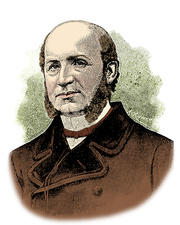Index
Guillaume-Benjamin-Amand Duchenne de Boulogne (September 17, 1806 – September 15, 1875) stands as one of the towering figures in the history of neurology, credited with groundbreaking advancements in electrophysiology and diagnostics. His relentless curiosity and innovative spirit not only paved the way for modern neurology but also immortalized his name through the syndromes and techniques he discovered and refined.
Early Life and Education

Born in the French coastal town of Boulogne-sur-Mer, Duchenne initially studied medicine in Paris, earning his degree in 1831. Though his early career was overshadowed by personal tragedy and professional setbacks, including the untimely death of his wife and subsequent societal prejudice, Duchenne’s dedication to understanding the human body never wavered.
Advancements in Electrophysiology and Diagnostics
Duchenne’s contributions to the science of electrophysiology marked a transformative era in medicine. He was the first to formalize the principles of electrical stimulation for diagnosing and treating diseases, culminating in his seminal 1855 textbook, De l'electrisation localisée et de son application à la physiologie, à la pathologie et à la thérapeutique. This work established diagnostic principles that are still foundational today, including nerve conduction studies (NCS). His companion atlas, Album de photographies pathologiques, broke new ground as the first neurology text illustrated with clinical photography.
Duchenne’s inventive mind also led to the creation of new diagnostic tools, including Duchenne’s trocar, a device for performing muscle biopsies. This innovation allowed him to study muscle tissue in vivo and deepen his understanding of neuromuscular disorders.
Contributions to Neurology and Myopathies
Duchenne’s name is synonymous with several neuromuscular disorders, reflecting his detailed observations and diagnostic acumen:
- Duchenne Muscular Dystrophy (DMD): Described as "childhood hypertrophic paraplegia" in 1861, this condition became his most renowned discovery. His meticulous clinical descriptions of pseudohypertrophy of the calves, proximal muscle weakness, and disease progression remain central to understanding DMD.
- Duchenne-Aran Spinal Muscular Atrophy: A form of progressive muscular atrophy distinguished by Duchenne’s diagnostic criteria.
- Duchenne-Erb Paralysis: A form of brachial plexus palsy impacting newborns.
- Duchenne's Disease (Tabes Dorsalis): His work contributed to understanding the neurodegenerative effects of syphilis on the spinal cord.
- Duchenne's Paralysis (Progressive Bulbar Palsy): His clinical observations helped elucidate this form of motor neuron disease.
Legacy and Impact
Duchenne’s work extended beyond his discoveries in disease. He revolutionized the understanding of neural conductivity and the effects of lesions on neural pathways, ushering in an era of diagnostic innovation. He was among the first clinicians to use deep-tissue biopsies and electrotherapy systematically, and his photographic documentation remains a testament to his commitment to merging art and science.
Despite his groundbreaking work, Duchenne faced significant professional resistance. Mocked for his provincial roots and often excluded from academic circles in Paris, he persisted, earning recognition in his later years. His collaborations with luminaries such as Jean-Martin Charcot further solidified his influence on the burgeoning field of neurology.
Final Years and Enduring Legacy
Duchenne passed away on September 15, 1875, at the age of 68, succumbing to hemorrhagic bleeding after years of illness. His final days were spent documenting his observations on his own progressive hemiparesis—a testament to his unrelenting dedication to science.
Guillaume Duchenne’s legacy endures not just in the syndromes that bear his name but in the principles of meticulous observation, innovation, and patient-focused care that continue to define neurology. He remains an enduring inspiration to clinicians and researchers worldwide, his life and work a bridge between the art and science of medicine.
Further Reading
- Kristian Borg (1992) The man behind the syndrome: Guillaume Duchenne, Journal of the History of the Neurosciences: Basic and Clinical Perspectives, 1:2, 145-154, DOI: 10.1080/09647049209525526
- Wikipedia contributors. (n.d.). Guillaume Duchenne de Boulogne. In Wikipedia. Retrieved December 27, 2024, from https://en.wikipedia.org/wiki/Guillaume_Duchenne_de_Boulogne
